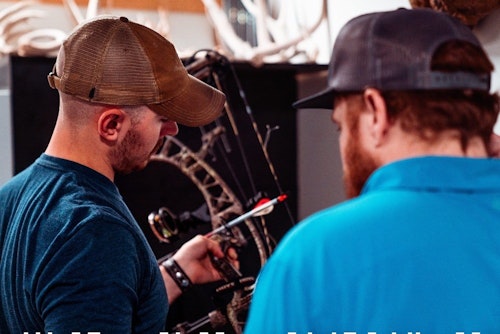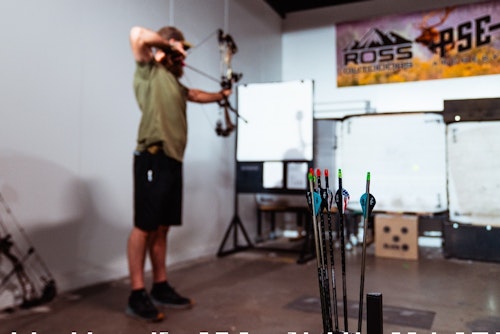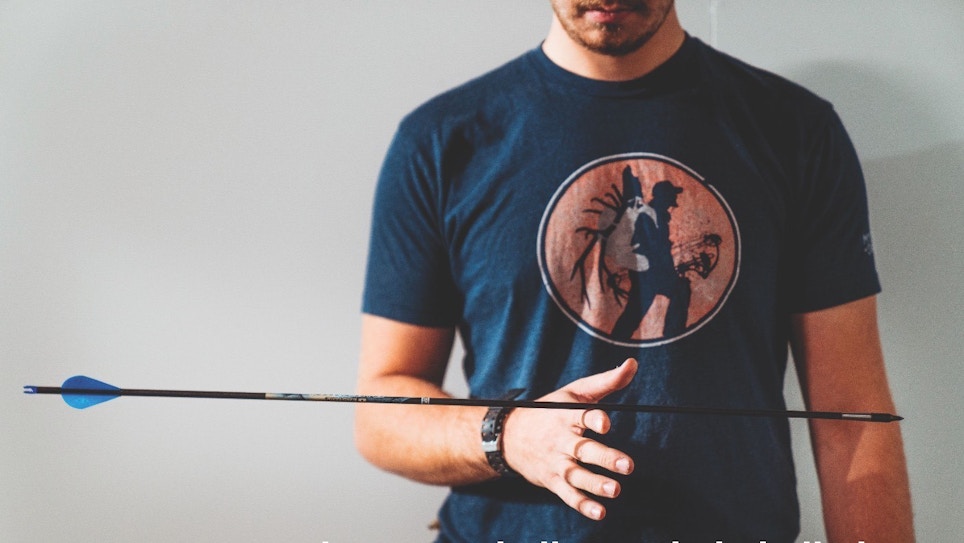The ebbs and flows of trends within the archery world are undeniable. Trends pop into the limelight, with some proving much more useful than others. As a result, pro shops have the responsibility to guide their customers in the right direction.
In the information age we live in, it is now easier than ever for consumers to gain access to and come up with their own theories. In one sense, it’s great that we all have quick access to an endless library of resources. However, without expert guidance, popular trends can unfortunately send archers down the wrong path.
In recent years, one of these new trends making its presence known is extreme front of center arrow setups. Potential customers consume information on a podcast or via an article that they read. Social media and social influencing can fuel the trend, too. Is this new extreme F.O.C. trend one that will stand the test of time, or will it fade from the limelight?
What is F.O.C.?
Before we dive into the extreme front of center craze, let’s take a quick look at what front of center is. Front of center (F.O.C.) is a measurement that describes the percentage of an arrow’s total weight (with broadhead) located in the front half of the arrow.
To determine an arrow’s F.O.C. requires a little measuring and a little math. Step one: Measure the arrow’s overall length from the throat of the nock to the end of the shaft and divide it by two. Step two: Using a fulcrum, find the perfect balancing point of the arrow and mark it. Next, measure the distance between the balance point and the throat of the nock. From there, subtract the arrow measurement in the first step from the measurement taken in step two. Multiply that answer by 100, and then divide that number by the arrow’s overall length. That number is the arrow’s F.O.C. percentage. In general, the longtime standard for appropriate F.O.C. for a hunting arrow has been between 10 to 15%.
Benefits of Extreme F.O.C.
When we say “extreme front of center,” we’re referring to an F.O.C. that is 20% or more. These days an increasing number of archers, especially bowhunters, gravitate toward extreme front of center arrow setups. Why? Because the heavy weight up front is essentially guiding the arrow, pulling it to the target, and actually then through the target, or animal. That’s not the only benefit to heavy F.O.C., either.
There’s also a claimed benefit to arrow flight. For consistent arrow groups and better flight, an arrow needs to properly recover from any oscillation. When I say correctly, I mean not too fast and not too slow. Either end of that spectrum yields poor results. The stabilized back end of the shaft now has a better chance to take over steering the arrow back on track.
Still, there is much left to learn about extreme F.O.C. setups. We know that several experienced bowhunters out there swear by and depend on an extreme F.O.C. arrow setup. The proof is in the pudding. Is it?

Pitfalls of Extreme F.O.C.
While the proof may be in the pudding for many accomplished bowhunters, that particular flavor of pudding might not be the best for everyone. There is definitely a downside to extreme F.O.C. arrow setups, which deserve mention here, too.
The first is arrow flight. I mentioned above that the F.O.C. fans claim better arrow flight, but it isn’t that easy. When more point weight is added to the front of an arrow, it also weakens its spine. This means that the arrow may not recover as fast, which can affect arrow flight. This effect can be a potential nightmare for tuning.
Furthermore, more times than not, it ends with a bowhunter having not only extreme F.O.C. but an extremely heavy arrow — weights like 600 to 700 grains. An extremely heavy arrow will drastically decrease speed. While speed isn’t the only variable, it is a valuable component of kinetic energy. Optimal kinetic energy requires a perfect blend of speed and weight.
Finding the right setup to achieve these extreme percentages is the key to success. A lighter grain per inch arrow will definitely help keep the overall weight down. There really aren’t any proven benefits over a more conservative and balanced arrow set up at the end of the day.
How to Handle the Craze
With the craze that is extreme F.O.C., you are surely going to encounter customers who are interested in this trend. These people likely heard about a “magical” arrow setup on a podcast or watched a YouTube video. By the time that they come into your shop, they essentially know everything there is to know about extreme F.O.C. and merely want you as the professional to build the exact arrow that they desire. As a service-based business, this is your job. However, it is still vital to find out the desire(s) of the customer is looking for in an arrow to provide the utmost service.
So, how does one handle this pre-educated customer requesting extreme F.O.C.? To find out the answers to that question, I discussed the issue with Grady Schneider from Ross Outdoors in Phoenix, Arizona. Below are his thoughts on the subject.
Do Some Friendly Digging
JK: What is the first step to helping a customer interested in an arrow with an extreme F.O.C.?
GS: The first thing to do is to do some friendly digging on the matter and see how excited they are about this extreme F.O.C. thing. Find out what their goals are with an arrow. Note what animals they are planning on hunting, what arrow weight they are shooting for, and if they care about arrow speed at all. Those questions right there are going to help pick the best direction for that customer. Each customer is different and deserves your full attention on the matter. They are putting their faith in you as the professional to steer them in the right direction, as well as their arrows. Knowing these answers, plus their basic bow specs (draw length, poundage, etc.), will help paint the picture of if extreme F.O.C. is actually worth pursuing, or even realistic for them and their setup.
Educate Them
JK: How do you ensure the customer understands arrow flight and F.O.C.?
GS: Spending the time to really educate customers is what will keep customers coming back. Doesn’t matter if it’s 10 minutes or an hour. Take the time to really educate them on the matter at hand.
In this case, they may know all there is to know about extreme F.O.C. on its own, but they usually lack knowledge of how this affects an arrow and arrow flight. The customer probably doesn’t know that by putting a bunch of weight up front, they are actually weakening their arrow spine, giving them wonky arrow flight and horizontal nock travel. They aren’t aware that if an arrow isn’t flying perfectly straight, their penetration will suffer due to that energy not traveling straight down the shaft. And while this may be crushing for them, they don’t know that some setups are just not feasible for extreme F.O.C. It works for some people, but it definitely does not work for all. This is a common misconception.
As you probably know, about 12% F.O.C. is fantastic for most people, not 20% like some folks request. At the end of the day, whether they are getting an extreme F.O.C. setup or not, good arrow flight is critical. The final decision is really up to them, though.
Seeing Is Believing
JK: What visualization tools do you use?
GS: There is a vast difference between just telling someone something and showing them something. Seeing really is believing, and by having shop arrows or demo arrows on hand, you can do just that. Have shop arrows cut at different lengths and different spines set aside for this purpose. By truly showing someone what a specific arrow setup is going to do out of their very own bow, you’ll be able to better educate them on the matter, thus giving them the tools they need to make a decision on if extreme F.O.C. is really worth them chasing or not. Shoot each setup through paper to find out what is going to work for their setup. A visual answer speaks much more volume than just believing what someone (you) says.

The Customer Is Always Right
JK: A customer that is set in their ways can be a challenge to help. How do you handle this type of customer?
GS: At the end of the day, the customer is always right. Arguing, no matter your personal opinion, is simply not worth it. This is where some archery shops fall short. They are too emotionally invested in their own opinions that they fail to respect the customer’s. What do you get? A person who goes off and learns how to do everything independently because of a bad experience. Now, a healthy conversation, though? That is a different thing entirely. Bending one another’s ear back and forth is great for not only education, but it builds a foundation for a possible longtime relationship between customer and shop. Your job is to fuel and prepare them for their passion, which is bowhunting. It is not your job to change their opinion. Inform, don’t argue, and make the customer happy.

Closing Thoughts
Whether this extreme F.O.C. trend is here to stay, or it will dwindle over time, one thing is true: customers are requesting it right now. Because of that, pro shops must be prepared to handle these consumer’s needs. There are definitely some attractive aspects of it, and pitfalls, too. Only time will tell if heavy point weight will carry its theory through until the end of time.






